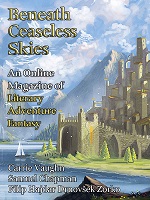 Beneath Ceaseless Skies #392, October 5, 2023
Beneath Ceaseless Skies #392, October 5, 2023
“The Tyrant’s Heir’s Tale” by Carrie Vaughn
“The Light of Setting Suns” by Samuel Chapman
“Between Blades” by Filip Hajdar Drnovšek Zorko
Reviewed by Victoria Silverwolf
In honor of the magazine’s fifteenth anniversary, this issue offers a bonus novella in addition to the usual pair of short stories.
“The Tyrant’s Heir’s Tale” by Carrie Vaughn takes place several years after rebels overthrew a tyrannical king who ruled by evil magic. The leader of the rebels is dead, and his son is now king. In a clandestine meeting with the surviving rebels, he elicits the truth behind the corpse of a woman, who had apparently just given birth, that was found hidden in his castle.
This synopsis makes the story sound melodramatic, but in fact it is a quiet tale, consisting mostly of conversation. Multiple characters offer their own versions of what happened, some of them obviously untrue. Readers are likely to predict the story’s conclusion once a certain character is introduced.
In “The Light of Setting Suns” by Samuel Chapman, a man relates his life story to his granddaughter. The setting is a fantasy world in which multiple islands float in the air above the ocean. As a young man, the grandfather was forced to live on one of the islands by the empire that conquered his people. The intent is for him to determine if it is inhabitable, so they can colonize it. An extraordinary event occurs, enabling the man to escape, but only at a great cost. The conclusion of his tale reveals why it is vital for his granddaughter to hear it.
The fantasy content of this story is vivid and original. The plot combines hope and tragedy in a perfectly balanced way. The man’s loss and his concern for his granddaughter supply strong emotional appeal.
“Between Blades” by Filip Hajdar Drnovšek Zorko is the magazine’s extra novella. In this fantasy world, gladiatorial contests involve pairs of fighters working together, one of whom literally transforms into a weapon. (The contests are not to the death, so they are more like athletic competitions than bloody battles.) One of the protagonists is the weapon; she changes into a spear. The other has the minds of two siblings within one body.
The spear-woman fled her family because she could not follow their rigid traditions. She hopes that victory in competition will allow her to leave the outskirts of the empire and travel to one of its major cities. Her partner has her own motive for fleeing her homeland, but is reluctant to go to the metropolis for an unspoken reason. When they reach the place, the partner’s past leads to a serious crisis for both.
The pace is leisurely, allowing the author to create a complex imagined world, but the plot leads to a dramatic climax. The theme of being allowed to make one’s own choices, even if that means making many mistakes along the way, occurs throughout the story in many ways. At times, the plot slows down to allow the characters to discuss this subject. Some readers may find this discussion overly blatant, as if the author is explaining the point of the story. The crisis that leads to the conclusion struck me as a little artificial.
Victoria Silverwolf likes this issue’s cover illustration.